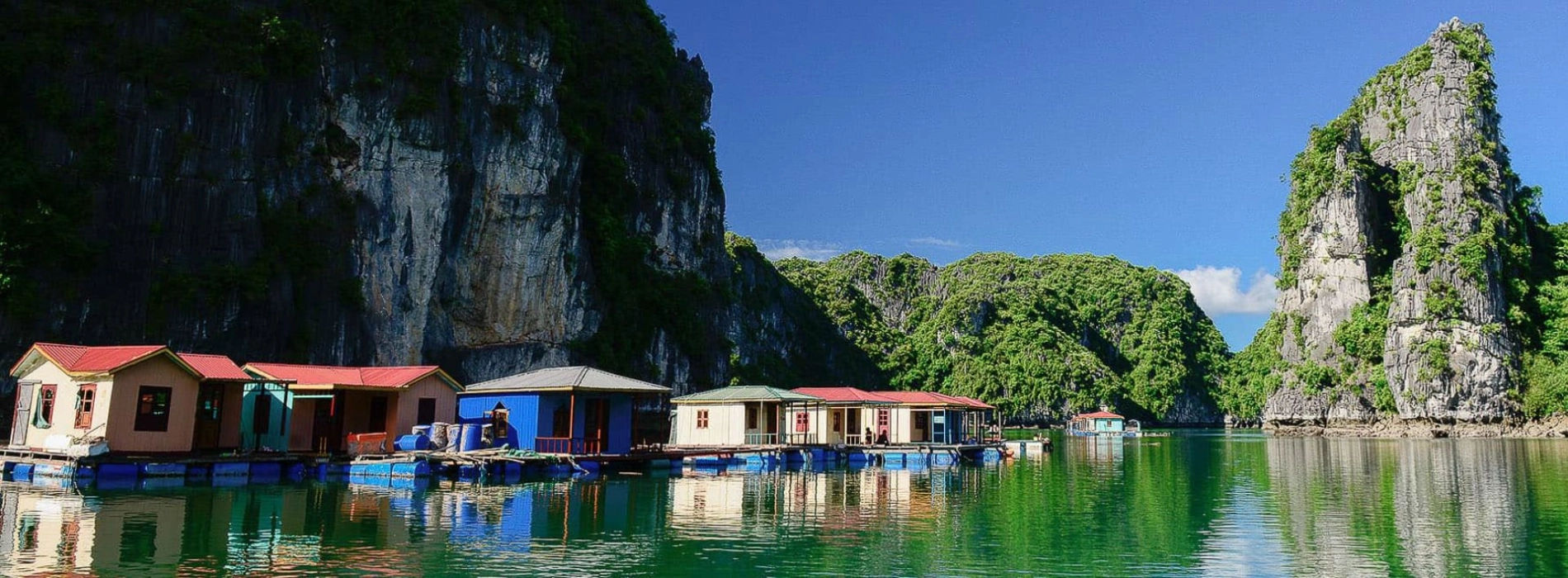Vung Vieng Fishing Village

Vung Vieng Fishing Village is the most beautiful and culturally relevant site in Vietnam's Bai Tu Long Bay, Quang Ninh. The floating village gives visitors an authentic experience of Vietnam's folk fishing culture with unparalleled natural beauty. Away from the popular tourist attractions, Vung Vieng is a tranquil and serene escape for travelers looking to engage more closely with nature and local ways of life.

Vung Vieng Fishing Village (Source: vietnamdiscovery)
Vung Vieng Fishing Village is a historical village rich in heritage tracing its roots to the early period of Vietnam's seashore culture. The village was established centuries ago when the local fishermen sought safe and viable ways to make a living out of the sea. They built floating homes through generations and settled as a pearl farming and fishing community. Over time, families passed down their sea borne skills, evolving a unique and independent style of life.
At its peak, Vung Vieng was home to hundreds of villagers who lived completely on the water. They relied on fishing, aquaculture, and commerce with mainland villagers. The Vietnamese government recognized the cultural significance of the village and attempted to preserve its traditions as well as improve the living conditions of its inhabitants. Over recent years, residents have relocated to the mainland under government schemes, yet the village is still maintained as a tourist and cultural attraction.

History of the fishing village (Source: vietnamdiscovery)
The best time to visit Vung Vieng Fishing Village is the dry season, between October and April. The weather is mild with clear blue skies and flat seas during these months, and it is perfect for boat cruises, kayaking, and visiting the floating village. The temperature is between 18°C and 25°C (64°F and 77°F), which is perfect for outdoor excursions.
May to September is when the region experiences hotter temperatures and isolated heavy rains due to the monsoon. Though the period may be nice enough and not crowded, improvisation in the storm may destroy travel plans. Traveling in the rainy season must be prepared for by making sure that weather reports are examined before arrival and for possible rearrangements of the itinerary.

Best time to visit (Source: reneacruiseshalong)
The village itself is one of the most popular attractions in Vung Vieng. The floating houses, which are constructed on solid bamboo rafts, provide a captivating spectacle against a backdrop of karst limestone. Tourists can join a boat tour guided by local fishermen who regale them with tales of their lives and village history. The tour provides an opportunity to observe how the villagers make a living from fishing and pearl farming.
Wandering (or drifting) around the village, tourists have a view of houses, a floating school, and small community areas where people gather. Despite modernization, the majority of traditional fishing practices continue, and tourists can see for themselves how the villagers throw nets and pearl farms. The peaceful and slow pace of life in Vung Vieng is the antithesis of the bustle of urban life, and tourists can indulge in the simplicity and elegance of this unorthodox way of life.

Floating houses of the village (Source: halongbaycruisehunters)
For adventure-lovers, kayaking in the clear and calm waters of Vung Vieng is a pleasure not to be missed. One can paddle around the giant limestone peaks that ring the village. These spectacular karsts shoot hundreds of feet into the air at some points and create a practically surreal ethereal landscape.
Kayaking gets one up close and personal with the bay's beauty as visitors can paddle through hidden caves and lagoons that larger boats cannot access. Some of the most stunning spots are secluded beaches, rock arches, and silent inlets where the only sound is the gentle lapping of the waves and the occasional cries of seagulls. It is perfect for nature lovers and photographers who want to capture images of the untouched beauty of Bai Tu Long Bay.

Visitors experience kayaking (Source: Vinpearl)
Read more: Ha Long Bay Trip Full-day: Jewel of Northern part
Vung Vieng is also known for its pearl farming industry, and a pearl farm visit is an educational way of experiencing this local custom. There are some pearl farms within the village that tourists can visit to witness the entire process of pearl farming from seeding oysters to harvesting and processing pearls.
Led tours of such farms provide an insight into the meticulous procedures involved in raising quality pearls. Tourists have the opportunity to witness skilled artisans placing foreign substances in oysters to prompt the growth of pearls, something that takes years. The farm laborers also explain the differences between various types of pearls and their value in the jewelry industry.

Visiting the Pearl Farms (Source: starlightcruiseshalong)
Drive to Ha Long City: Ha Long City is the largest city near Vung Vieng and is well linked by road from Hanoi. It takes about 2.5 to 3.5 hours, depending on traffic. Visitors can opt for private car hires, shuttle buses, or luxury limousines for a smoother journey.
Take a Cruise or Boat Tour: After arriving in Ha Long City, tourists need to book a cruise or boat tour that includes Vung Vieng in the itinerary. Day tours or overnight cruises of Bai Tu Long Bay with stops at Vung Vieng are offered by various operators. The tours are hassle-free, with food, kayaking, and guided tours of the village typically included in the package.

Boat tour in HaLong Bay (Source: vietnamtonkintravel)
Vung Vieng Fishing Village is a well-recommended destination for tourists who wish to explore more of Vietnam's culture and nature. It is an intriguing destination with a rich history, stunning landscape, and unusual floating lifestyle. Book a tour with Asia King Travel today and explore this lovely destination.
Read more: Enchanting Fishing Villages of Vietnam